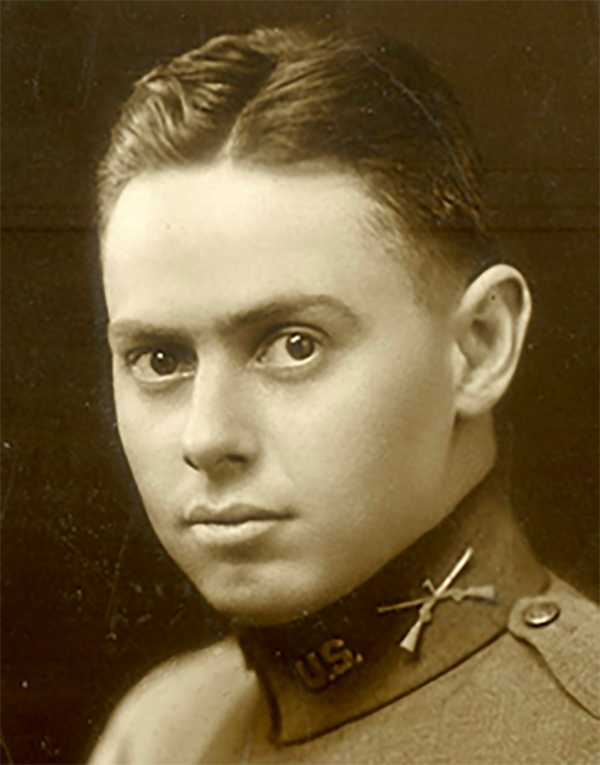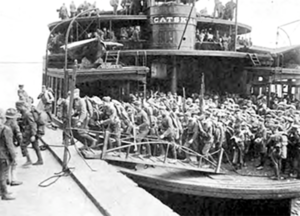
Young Newell as he entered the Army as a 2nd Lieutenant.
Meet Captain Newell Rodney Fiske, Cranford’s First Death in Battle One of Cranford’s 86
By Don Sweeney with Lt. Col. Steven Glazer (Ret.), Cranford Historical Society

Newell R Fiske’s formal portrait after being promoted to Captain
As the team committed to tell the stories of Cranford’s 86 war heroes who gave their lives for our freedom, we think about these young men throughout the year. For many of us, Memorial Day focuses our thoughts on the sacrifices these young men made. I hope the ten stories we have told this year have caused others to reflect on those to whom we owe so much. This year when you hear the names read at Memorial Park you will see the faces and know the stories of these brave young men who have allowed us to live the wonderful life paid for with their sacrifice. Reading the many biographies of the Cranford 86, I often came to the overstuffed file of Captain Newell Rodney Fiske as I went through the selection process to pick our hero of the month. Knowing the 100th anniversary of his death was coming up this year, we purposely waited to tell this amazing story. At the time of his death, he was said to be the finest young man to come from Cranford. He still may be. With my partner Steve Glazer and a large folder from the Cranford Historical Society marked “Newell R. Fiske,” the window to life in the early 1900’s in Cranford began to open. Each month as we open a hero’s file and dig into the internet’s research portals, we uncover the details of the lives of our greatest citizens. I find myself empathizing with the family and friends of our hero; my own emotions take hold as I type each word. This month would be no exception. The only son of Mr. and Mrs. Harvey Fiske, a prominent family from Brooklyn, they summered in West Hampton on Long Island, still today the summer playground for New York’s society elites. The Fiske and Dean (Mrs. Fiske’s maiden name) families were often mentioned in the society pages. It was in West Hampton on August 10, 1894, that Newell was born. The family moved to Cranford when he was 3 years old, first to 8 Hampton St., then to 116 Eastman St., before settling at 301 Prospect Ave. Our research found that the homes in this upscale neighborhood were built just after the turn of the century. Newell started his educational path in Cranford public schools before entering Pingry in Elizabeth, then attending Cheshire School, an elite boarding school in Connecticut for grades 9 through 11. For senior year, Newell attended Lawrenceville Academy, another prestigious boarding school 40 miles south of Cranford. Newell then enrolled at Princeton University as a member of the class of 1918. However, after such a prestigious education, he left the Ivy League in his freshman year to “take up war work” in 1914. Enrolling the following year at the Citizen Military Training Camp (CMTC) in Plattsburgh, NY, Newell began his preparation for a military career. The CMTCs were often attended by the sons of wealthy businessmen and political power brokers. Tuition was expensive and no public funds were available. Graduates of this inaugural class of CMTC went on to such careers as the youngest mayor of New Yok City, an Episcopal bishop, a US secretary of state, a founder of a major Wall Street trading firm, and a leading Manhattan lawyer. While there, Fiske became friends with Quentin and Archie Roosevelt, the two youngest sons of President Theodore Roosevelt. They had lived at the White House during their father’s presidency. Archie became the tent-mate of Newell, a fellow Ivy Leaguer. The three friends would later go off to war. As a well-trained civilian in soldierly skills, Newell split his time between Washington, DC, where he studied war subjects, and Cranford, where he organized and drilled the Cranford Home Guard, which later became the Cranford company of the State Militia Reserve. While in town, Fiske would speak at school assemblies and at the Cranford’s “moving picture theater,” talking about the CMTC as well as the Liberty Loan program, the beginning of the war bond movement. America was anticipating its entry into the war then raging in Europe. In January 1917, Newell took the test for a Regular Army second lieutenant at Fort Myer in Virginia. And on April 6, 1917, Congress finally entered the Great War, with the US joining France, Russia and Great Britain as the Allied forces against Germany. Exactly two months later, Newell received his officer’s commission, along with orders to report to Ft. Leavenworth, Kansas. There on August 5, he was promoted to first lieutenant and assigned to the US Seventh Infantry. On February 1, 1918, Lieutenant Fiske was selected to travel to Aurora, Ill, for training in cryptology, the science of decoding secret messages, after which he was sent to Charlotte, NC, where he was promoted to captain on March 22, 1918. On March 28 at 5:30 p.m., Captain Fiske came through Cranford while traveling with his regiment to Camp Merritt in Cresskill, NJ, the gateway to the European theater for many American soldiers. Of the four million soldiers deployed to Europe during the war, one million went through Camp Merritt. From there they would take ferry boats down the Hudson River to Hoboken, where they boarded transatlantic ships to the Western Front. On April 6, 1918 — the first anniversary of the nation’s entry into the First World War — Captain Fiske sailed from Hoboken to the battlefields of France on the USS America. In his last letter from “over there” to his parents on May 30, Fiske reported that he was doing considerable travelling and that he was in command of a company in his regiment. It was assumed he had arrived at the front. Fiske’s first fighting was at the Marne River at the Battle of Chateau Thierry.

(above) Ferry boat’s transfer WW1 soldiers from Ft. Merritt to Hoboken to board The USS America in route to the European theater.
The battle lasted four months, from June 3 to October 10. It was said to be the turning point of the war. The Germans were having their way pushing the French and British forces back daily since June 3. They were marching toward Paris, just 50 miles away. A victory for the Germans would have most likely won them the war. The Russians had already pulled out due to their own revolution at home. France was experiencing low morale, with its citizens vehemently protesting the war. The British were outnumbered and fatigued from being beaten into retreat every day. The Germans were aware that the US was entering the war and were anxious to deal a decisive blow to the Allied forces before the fresh troops arrived. In the late days of June a steady flow of young, recently trained, untested American soldiers started arriving in the area around the Marne. By the first week, 270,000 soldiers were in place. The entire war was about to change. One oft-repeated story was of a French commander discussing a retreat order to the Allied forces. An American Marine commander responded, “Retreat? We just got here!” From that point it is said that the Allies changed from a defensive stance to an all-out offensive posture, launching six assaults “over the top,” altering the tide of battle. The Germans were forced to retreat. In one wave alone, 15,000 German prisoners were taken. The Second Battle of the Marne, from July 15 to August 6, was the true turning point of the war. The Allied forces, now being commanded by an American general, John “Black Jack” Pershing, numbered 1.2 million. It was at the beginning of this engagement that Captain Newell Rodney Fiske was killed as he led his troops in a counterattack through intense artillery fire, inspiring his men by his gallant conduct. It was the success of this battle that set up two months of dominance by the Allied forces. One month after the conclusion of the Battle of Chateau Thierry, the Germans surrendered and the Armistice was signed on November 11, 1918. “The War to End All Wars” was over. In total, some 10 million men under arms were killed in the war. According to one report, 116,708 Americans perished. Fifteen were from Cranford. Reports after the fight say that on July 15, 1918, Captain Fiske met his end, the first American officer to die in the battle. Just one day earlier, his CMTC friend Quentin Roosevelt died in the skies over France in aerial combat. Newell was one month shy of his 24th birthday. He was posthumously awarded the Distinguished Service Cross for bravery in action. It was presented to his grieving father. The August 1, 1918, Cranford Chronicle reported that a telegram had been received on July 26 at the home of Mr. and Mrs. Fiske notifying them that their son was dead. Accounts of Cranford’s first battle death spread through town. Expressions of grief and sympathy were soon pouring into the Fiske home. Flags were flown at half-mast for two days following the arrival of the mournful news. It was said that Newell Fiske was better known than any other Cranford boy. Always of a venturesome nature, he was prominent in everything he undertook. “The name of young Fiske is now numbered among the immortals,” said Dr. George Greene upon hearing of his death.

Captain Fiske’s final resting place in Oise-Aisne American Cemetery in France.
The First Presbyterian Church pastor said in his eulogy that the captain “gave the last full measure of his devotion to his country- dying as one might well wish to die-and we bow reverently to the will of God, with pride that our community has had so brave a son, for I doubt if there is a braver heart within the bosom of any one of a million and more of our boys who are facing the German line than was his. His love of country was intense and sincere, and his courage was superb.” In his honor, the family set up the Fiske Scholarship at Princeton University. And his father was instrumental in founding the Cranford V.F.W., which proudly bears the name Captain Newell Rodney Fiske Post # 335. It was dedicated with a ceremony honoring Captain Fiske on March 30, 1920. Cranford’s Fiske Terrace was also named in his honor. Surviving family members were his father Harvey N. Fiske, mother Florence Dean Fiske and sister Marion Dean Fiske Miller. Captain Newell Rodney Fiske is buried in France at Oise-Aisne American Cemetery. He was a great American and one of Cranford’s 86. This concludes our first year of stories of the Cranford 86 hometown heroes. It is planned to honor each profiled hero with a banner to fly over the streets of Cranford. They will be dedicated at this year’s Memorial Day service following the parade. The stories that have been featured all year in Cranford Monthly will be available at the ceremony in a booklet for a nominal charge to cover printing costs.

(above) Cartoon depicting the turning point battle of WW1

Civilian Military Training Camps in Plattsburgh NY.

(above) USS America 1916.

Fiske Terrace dedicated to the memory of Captain Fiske.